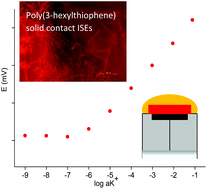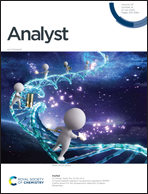Ion-selective membrane plasticizer leakage in all-solid-state electrodes – an unobvious way to improve potential reading stability in time†
Abstract
The effect of leakage of the plasticizer from the ion-selective membrane into the ion-to-electron transducer of all-solid-state potentiometric sensors is considered for the first time. The plasticizer can be transferred to the transducer phase, either during ion-selective membrane application or later; in both cases, its presence can affect the performance of the sensors. Clearly, this effect is most pronounced if the transducer is dispersible in the plasticizer. Towards this end, it is shown that application as the transducer of plasticizer dispersable poly(3-hexylthiophene) compared to typically used (non-dispersible) poly(3-octylthiophene) results in sensors offering higher reproducibility of recorded potentials equal to ±1.4 mV and ±2.5 mV, respectively (within-day test, n = 6). Although poly(3-hexylthiophene) was also found in the membrane in the solvent dispersed, neutral emission active form, the analytical parameters of poly(3-hexylthiophene) based sensors including selectivity were improved or comparable to those of classical poly(3-octylthiophene) transducer sensors.



 Please wait while we load your content...
Please wait while we load your content...